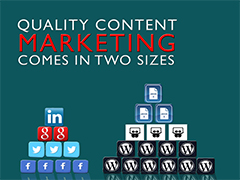Quality Content Marketing Comes in Two Sizes

This blog post was written by Fernando Ramirez. Fernando is a marketing intern for Magnetude Consulting with a specific focus on content marketing, social media, and data analysis.
Creating Short-form & Long-form Quality Content to Generate & Keep Site Traffic
Learning how to create quality content is a powerful force for social movement, and can only be appreciated by understanding how much data is being created on the web every single minute. For someone who belongs to a young startup company or is in the planning stages, here’s a little information on what’s happening in three of the largest social media channels on the web per minute:
Per Minute
- Facebook – 684, 478 shares
- Twitter – 100,000 tweets
- YouTube – 48 hours of video content uploaded
Here’s an idea of what’s going on with blog posts:
Per Minute
- Tumblr – 27,778 new blog posts
- WordPress – 347 new blog posts
Now, for a startup that is attempting to carve out some digital space of its own, the initial first steps can feel like you have to explode onto the scene in super nova fashion. Appealing to your audience through quality content is no easy trick. It demands persistency and a clear and deliberate message that is reinforced over and over again to meet the business needs of your startup and the content needs of your target audience.
Creating quality content is not just about quick tweets, one-off blog posts and leveraging the latest and greatest social media tools just for the sake of it. Building quality content should be well thought out, carefully prioritized, creative, fun, and engaging.
Defining Content Marketing
A startup’s content marketing strategy should look to create relevant and valuable content aimed at attracting and engaging a transparently defined audience. Content is what’s being produced. Acquiring new business through content should be one of your startup’s marketing goals. After all, the ultimate value for measuring success is profitability.
Generating specific content to support your marketing plan can be done through two known approaches. The first type is called short-form content, like a tweet or infographic. The short-form content is meant to be quick and easy to read. The other content type is known as long-form content, which is a meatier content, such as eBooks or whitepapers, for example.
The Pros and Cons of Short-form vs. Long-form
Short-term content is relatively easy to produce and cost-effective. The negative side effects are a lower level of investment from the audience, higher turnover rate with content effectiveness, and shorter virtual life spans. On the flip side, long-term content is takes more time and resources, but provides you with a library of thought leadership and expertise to help your startup establish meaningful relationships with your future customers.
For example, Magnetude recently worked with a client to develop a content strategy to achieve near-term lead generation goals. Based on the skillsets of the team and their resources,we formulated a 6 month editorial calendar that included curated social media content (short-form), ongoing and frequent blog content, and eBooks to distribute on Slideshare (long-form). The combination of content types helped them drive more traffic to their website through frequent content output, while creating deeper engagement with their prospects through long-form content.
The Goal
Both forms of content should be planned to operate coherently as part of your quality content plan. The balance between the two will depend on how you decide to build and execute your marketing plan. Look at both forms of contents as stepping stones to generating awareness and leads through content, and leveraging social media, email marketing, and other inbound and outbound tactics to get that content into the hands of your target customers.
If you have questions around how to develop your content marketing strategy, contact us today for a complimentary consultation.